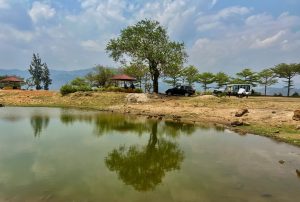Rwanda has a diverse range of trees that play a crucial role in its environment, economy, and culture. The country’s forests are home to both indigenous and introduced tree species, many of which contribute to conservation efforts, biodiversity, and sustainable development. Rwanda is home to about 390 tree species. The country’s forests, ranging from montane rainforests to savanna woodlands, support a rich variety of trees that contribute to biodiversity, climate regulation, and local livelihoods.
Data Products
Checklist of the Trees of Rwanda
Checklist of Protected Trees in Rwanda – resource link
Checklist of the Endangered and Threatened Trees of Rwanda
Checklist of Useful Trees and Shrubs for Agricultural and Pastoral Communities of Rwanda
Interactive Suitable Tree Species Selection and Management Tool for East Africa
Introduced Trees: About 50 common species, introduced for timber, agroforestry, and reforestation.
Indigenous Trees: About 390 species, found mainly in national parks like Akagera, Nyungwe, Gishwati-Mukura, and Volcanoes National Park.
An example of an endemic speceies, only found in Rwanda, is Rhamnus mildbraedii (POWO). This shrub species is critically endangered, and is only known from a single 1907 collection by Mildbraed (593).
There are at least 25 globally threatened species including 1 critically endangered, 8 endangered species and 16 vulnerable species.
Endangered
Maerua robynsii (Capparaceae) – view IUCN Red List
Beilschmiedia michelsonii (Lauraceae) – IUCN Red List
Pittosporum mildbraedii (Pittosporaceae) – IUCN Red List
Psychotria palustris (Rubiaceae) – IUCN Red List
Psychotria sublyrata (Rubiaceae) – IUCN Red List
Tarenna rwandensis (Rubiaceae) – IUCN Red List
Vepris renieri (Rutaceae) – IUCN Red List
Zanthoxylum renieri (Rutaceae) – IUCN Red List
Vulnerable Species
Isolona lebrunii (Annonaceae)
Harungana montana (Hypericaceae)
Beilschmiedia mannioides (Lauraceae)
Ocotea kenyensis (Lauraceae)
Ocotea michelsonii (Lauraceae)
Ochna afzelioides (Ochnaceae)
Cassipourea ndando (Rhizophoraceae)
Prunus africana (Rosaceae)
Ixora burundiensis (Rubiaceae)
Oxyanthus troupinii (Rubiaceae)
Pavetta urundensis (Rubiaceae)
Rytigynia kigeziensis (Rubiaceae)
Rytigynia ruwenzoriensis (Rubiaceae)
Zanthoxylum mildbraedii (Rutaceae)
Mimusops bagshawei (Sapotaceae)
Musanga leo-errerae (Urticaceae)
Kuria, A., Uwase, Y., Mukuralinda, A., Iiyama, M., Twagirayezu, D., Njenga, M., Muriuki, J., Mutaganda, A., Muthuri, C., Kindt, R., Betemariam, E., Cronin, M., Kinuthia, R., Migambi, F., Lamond, G., Pagella, T., & Sinclair, F. (2017). Suitable tree species selection and management tool for Rwanda. [Database], World Agroforestry Centre (ICRAF).
1. Indigenous Trees
These native species are vital for Rwanda’s ecosystems, providing habitat for wildlife and helping with soil conservation.
-
- Entandrophragma excelsum (African mahogany) – Found in high-altitude forests like Nyungwe National Park.
- Newtonia buchananii – Common in montane forests, providing shade and habitat.
- Afrocarpus usambarensis – A slow-growing tree that is found in Rwanda’s mountainous regions.
- Prunus africana (African cherry tree) – Valued for its medicinal bark, which is used to treat prostate issues.
- Ficus spp. (Fig trees) – Sacred in many Rwandan traditions and essential for bird and primate species.
2. Introduced Trees
Introduced for economic, agricultural, and reforestation purposes.
-
- Eucalyptus spp. – Widely planted for firewood, construction, and erosion control.
- Grevillea robusta (Silk oak) – Used for agroforestry and soil improvement.
- Pinus spp. (Pine trees) – Planted in highland areas for timber and paper production.
- Jacaranda mimosifolia – Known for its beautiful purple flowers, often seen in urban areas.
Forests and Conservation Efforts
Rwanda has made significant efforts to reforest the country and protect its natural forests, particularly in national parks:
-
- Akagera National Park – Dominated by acacia species and other savanna-adapted trees.
- Nyungwe Forest National Park – One of Africa’s oldest rainforests, home to diverse tree species and wildlife.
- Gishwati-Mukura National Park – A reforested area that was once heavily degraded but is now protected.
- Volcanoes National Park – Hosts bamboo forests, essential for mountain gorillas.
Importance of Trees in Rwanda
-
- Biodiversity – Rwanda’s forests support endangered species, including golden monkeys and mountain gorillas.
- Climate Regulation – Trees play a role in controlling erosion and maintaining rainfall patterns.
- Livelihoods – Many Rwandans depend on tree-related industries, such as timber, firewood, and herbal medicine.
- Cultural Significance – Trees like the fig tree (Umuvumu) hold spiritual and communal importance.
Challenges and Conservation
-
- Deforestation – Driven by agriculture, charcoal production, and urban expansion.
- Climate Change – Affecting rainfall patterns and forest health.
- Government Initiatives – Rwanda has launched projects like the Green Rwanda Initiative to restore forest cover.
